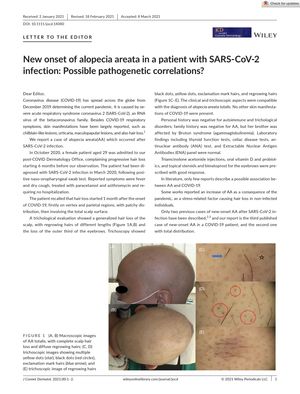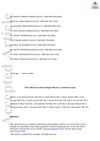New onset of alopecia areata in a patient with SARS‐CoV‐2 infection: Possible pathogenetic correlations?
March 2021
in “Journal of cosmetic dermatology (Print)”

TLDR COVID-19 infection may trigger alopecia areata in some patients.
The document reports a case of a 29-year-old female patient who developed alopecia areata (AA) following a SARS-CoV-2 infection. The patient experienced progressive hair loss starting one month after the onset of COVID-19 symptoms, which were treated without hospitalization. Clinical and trichoscopic evaluations confirmed the diagnosis of alopecia areata totalis. The patient's personal and family medical history did not suggest a predisposition to autoimmune or trichological disorders, and laboratory tests were normal. Treatment with triamcinolone acetonide injections, oral vitamin D and probiotics, and topical steroids and bimatoprost for the eyebrows resulted in a good response. The paper discusses the potential pathogenetic correlations between AA and SARS-CoV-2 infection, suggesting that the timing of the AA onset and the infection could be related. It is proposed that stress from the infection, as well as the virus itself, could trigger AA through mechanisms such as the interferon-mediated antiviral response and cytokine cascade activation, particularly involving IL-6, which may inhibit hair follicle proliferation. This case is the third reported instance of new-onset AA following a COVID-19 infection and contributes to the understanding of dermatological manifestations associated with the virus.
View this study on onlinelibrary.wiley.com →
Cited in this study

research SARS‐CoV‐2‐induced telogen effluvium: a multicentric study
COVID-19 infection may cause significant hair loss, but full hair recovery is likely without special treatment.
research Evaluation of the Relationship between Alopecia Areata and Viral Antigen Exposure

research Stress-induced premature senescence of dermal papilla cells compromises hair follicle epithelial-mesenchymal interaction
Stress can cause early aging in certain skin cells, leading to problems with hair growth.
Related
research Alopecia areata: A multifactorial autoimmune condition
Alopecia areata is an autoimmune disease causing patchy hair loss, often with other autoimmune disorders, but its exact causes are unknown.
research Linear alopecia areata
Alopecia areata can sometimes appear as a straight line of hair loss instead of round patches.
research Treating of resistant cases of alopecia universalis
Combining platelet-rich plasma therapy with prostaglandin-F eye drops can significantly regrow hair in alopecia universalis.